Passivation of Surface States in GaN by NiO Particles
Abstract
:1. Introduction
2. Materials and Methods
3. Results and Discussion
4. Conclusions
Author Contributions
Funding
Data Availability Statement
Conflicts of Interest
References
- Barletta, P.T.; Berkman, E.A.; Moody, B.F.; El-Masry, N.A.; Emara, A.M.; Reed, M.J.; Bedair, S.M. Development of Green, Yellow, and Amber Light Emitting Diodes Using InGaN Multiple Quantum Well Structures. Appl. Phys. Lett. 2007, 90, 151109. [Google Scholar] [CrossRef]
- Ohkawa, K.; Watanabe, T.; Sakamoto, M.; Hirako, A.; Deura, M. 740-Nm Emission from InGaN-Based LEDs on c-Plane Sapphire Substrates by MOVPE. J. Cryst. Growth 2012, 343, 13–16. [Google Scholar] [CrossRef]
- Zhuang, Z.; Iida, D.; Ohkawa, K. Ultrasmall and Ultradense InGaN-Based RGB Monochromatic Micro-Light-Emitting Diode Arrays by Pixilation of Conductive p-GaN. Photonics Res. 2021, 9, 2429. [Google Scholar] [CrossRef]
- Zhuang, Z.; Iida, D.; Velazquez-Rizo, M.; Ohkawa, K. 630-Nm Red InGaN Micro-Light-Emitting Diodes (<20 Μm × 20 Μm) Exceeding 1 MW/Mm 2 for Full-Color Micro-Displays. Photonics Res. 2021, 9, 1796. [Google Scholar] [CrossRef]
- Fujii, K.; Karasawa, T.; Ohkawa, K. Hydrogen Gas Generation by Splitting Aqueous Water Using N-Type GaN Photoelectrode with Anodic Oxidation. Jpn. J. Appl. Phys. Part 2 Lett. 2005, 44, 543–545. [Google Scholar] [CrossRef]
- Brunner, D.; Angerer, H.; Bustarret, E.; Freudenberg, F.; Höpler, R.; Dimitrov, R.; Ambacher, O.; Stutzmann, M. Optical Constants of Epitaxial AlGaN Films and Their Temperature Dependence. J. Appl. Phys. 1997, 82, 5090–5096. [Google Scholar] [CrossRef]
- Chichibu, S.F.; Hazu, K.; Ishikawa, Y.; Tashiro, M.; Ohtomo, T.; Furusawa, K.; Uedono, A.; Mita, S.; Xie, J.; Collazo, R.; et al. Excitonic Emission Dynamics in Homoepitaxial AlN Films Studied Using Polarized and Spatio-Time-Resolved Cathodoluminescence Measurements. Appl. Phys. Lett. 2013, 103, 142103. [Google Scholar] [CrossRef]
- Araki, T.; Saito, Y.; Yamaguchi, T.; Kurouchi, M.; Nanishi, Y.; Naol, H. Radio Frequency-Molecular Beam Epitaxial Growth of InN Epitaxial Films on (0001) Sapphire and Their Properties. J. Vac. Sci. Technol. B Microelectron. Nanometer Struct. 2004, 22, 2139–2143. [Google Scholar] [CrossRef]
- Vurgaftman, I.; Meyer, J.R. Band Parameters for Nitrogen-Containing Semiconductors. J. Appl. Phys. 2003, 94, 3675–3696. [Google Scholar] [CrossRef]
- Moses, P.G.; Miao, M.; Yan, Q.; Van De Walle, C.G. Hybrid Functional Investigations of Band Gaps and Band Alignments for AlN, GaN, InN, and InGaN. J. Chem. Phys. 2011, 134, 084703. [Google Scholar] [CrossRef]
- Moses, P.G.; Van De Walle, C.G. Band Bowing and Band Alignment in InGaN Alloys. Appl. Phys. Lett. 2010, 96, 2–5. [Google Scholar] [CrossRef]
- Minsky, M.S.; White, M.; Hu, E.L. Room-Temperature Photoenhanced Wet Etching of GaN. Appl. Phys. Lett. 1996, 68, 1531–1533. [Google Scholar] [CrossRef]
- Youtsey, C.; Adesida, I.; Bulman, G. Highly Anisotropic Photoenhanced Wet Etching of N-Type GaN. Appl. Phys. Lett. 1997, 71, 2151–2153. [Google Scholar] [CrossRef]
- Wang, F.H.; Krüger, P.; Pollmann, J. Electronic Structure of 1 × 1 GaN(0001) and GaN(0001) Surfaces. Phys. Rev. B-Condens. Matter Mater. Phys. 2001, 64, 0353051–0353058. [Google Scholar] [CrossRef]
- van de Walle, C.G.; Segev, D. Microscopic Origins of Surface States on Nitride Surfaces. J. Appl. Phys. 2007, 101, 81704. [Google Scholar] [CrossRef] [Green Version]
- Segev, D.; van de Walle, C.G. Origins of Fermi-Level Pinning on GaN and InN Polar and Nonpolar Surfaces. Europhys. Lett. 2006, 76, 305–311. [Google Scholar] [CrossRef]
- Baker, D.R.; Lundgren, C.A. Electrochemical Determination of the Gallium-Nitride Photocorrosion Potential in Acidic Media. J. Mater. Chem. A 2017, 5, 20978–20984. [Google Scholar] [CrossRef]
- Fujii, K.; Ono, M.; Ito, T.; Iwaki, Y.; Hirako, A.; Ohkawa, K. Band-Edge Energies and Photoelectrochemical Properties of n-Type AlxGa1−x N and InyGa1−y N Alloys. J. Electrochem. Soc. 2007, 154, B175. [Google Scholar] [CrossRef]
- Ono, M.; Fujii, K.; Ito, T.; Iwaki, Y.; Hirako, A.; Yao, T.; Ohkawa, K. Photoelectrochemical Reaction and H2 Generation at Zero Bias Optimized by Carrier Concentration of n-Type GaN. J. Chem. Phys. 2007, 126, 054708. [Google Scholar] [CrossRef]
- Hayashi, T.; Deura, M.; Ohkawa, K. High Stability and Efficiency of GaN Photocatalyst for Hydrogen Generation from Water. Jpn. J. Appl. Phys. 2012, 51, 50–52. [Google Scholar] [CrossRef]
- Ohkawa, K.; Ohara, W.; Uchida, D.; Deura, M. Highly Stable GaN Photocatalyst for Producing H2 Gas from Water. Jpn. J. Appl. Phys. 2013, 52, 2–4. [Google Scholar] [CrossRef]
- Yotsuhashi, S.; Deguchi, M.; Zenitani, Y.; Hinogami, R.; Hashiba, H.; Yamada, Y.; Ohkawa, K. Photo-Induced CO2 Reduction with GaN Electrode in Aqueous System. Appl. Phys. Express 2011, 4, 2–4. [Google Scholar] [CrossRef]
- Yotsuhashi, S.; Deguchi, M.; Hashiba, H.; Zenitani, Y.; Hinogami, R.; Yamada, Y.; Ohkawa, K. Enhanced CO2 Reduction Capability in an AlGaN/GaN Photoelectrode. Appl. Phys. Lett. 2012, 100, 2010–2013. [Google Scholar] [CrossRef]
- Hashiba, H.; Yotsuhashi, S.; Deguchi, M.; Yamada, Y.; Ohkawa, K. Selectivity Control of CO2 Reduction in an Inorganic Artificial Photosynthesis System. Appl. Phys. Express 2013, 6, 2–5. [Google Scholar] [CrossRef]
- Sekimoto, T.; Hashiba, H.; Shinagawa, S.; Uetake, Y.; Deguchi, M.; Yotsuhashi, S.; Ohkawa, K. Analysis of Products from Photoelectrochemical Reduction of 13CO2 by GaN-Si Based Tandem Photoelectrode. J. Phys. Chem. C 2016, 120, 13970–13975. [Google Scholar] [CrossRef]
- Velazquez-Rizo, M.; Iida, D.; Ohkawa, K. Photoelectrochemical and Crystalline Properties of a GaN Photoelectrode Loaded with α-Fe2O3 as Cocatalyst. Sci. Rep. 2020, 10, 12586. [Google Scholar] [CrossRef]
- Velazquez-Rizo, M.; Iida, D.; Ohkawa, K. Photoelectrochemical H 2 Generation from Water Using a CoO x /GaN Photoelectrode. Japanese J. Appl. Phys. 2019, 58, SCCC23. [Google Scholar] [CrossRef]
- Alqahtani, M.; Sathasivam, S.; Alhassan, A.; Cui, F.; Benjaber, S.; Blackman, C.; Zhang, B.; Qin, Y.; Parkin, I.P.; Nakamura, S.; et al. InGaN/GaN Multiple Quantum Well Photoanode Modified with Cobalt Oxide for Water Oxidation. ACS Appl. Energy Mater. 2018, 1, 6417–6424. [Google Scholar] [CrossRef]
- Maeda, K.; Teramura, K.; Saito, N.; Inoue, Y.; Domen, K. Photocatalytic Overall Water Splitting on Gallium Nitride Powder. Bull. Chem. Soc. Jpn. 2007, 80, 1004–1010. [Google Scholar] [CrossRef]
- Hou, Y.; Syed, Z.A.; Smith, R.; Athanasiou, M.; Gong, Y.; Yu, X.; Bai, J.; Wang, T. Enhanced Water Splitting with Silver Decorated GaN Photoelectrode. J. Phys. D Appl. Phys. 2016, 49, 265601. [Google Scholar] [CrossRef]
- Yoshida, M.; Yamakata, A.; Takanabe, K.; Kubota, J.; Osawa, M.; Domen, K. ATR-SEIRAS Investigation of the Fermi Level of Pt Cocatalyst on a GaN Photocatalyst for Hydrogen Evolution under Irradiation. J. Am. Chem. Soc. 2009, 131, 13218–13219. [Google Scholar] [CrossRef]
- Grimaud, A.; Diaz-Morales, O.; Han, B.; Hong, W.T.; Lee, Y.L.; Giordano, L.; Stoerzinger, K.A.; Koper, M.T.M.; Shao-Horn, Y. Activating Lattice Oxygen Redox Reactions in Metal Oxides to Catalyse Oxygen Evolution. Nat. Chem. 2017, 9, 457–465. [Google Scholar] [CrossRef]
- Yoo, J.S.; Rong, X.; Liu, Y.; Kolpak, A.M. Role of Lattice Oxygen Participation in Understanding Trends in the Oxygen Evolution Reaction on Perovskites. ACS Catal. 2018, 8, 4628–4636. [Google Scholar] [CrossRef]
- Nørskov, J.K.; Rossmeisl, J.; Logadottir, A.; Lindqvist, L.; Kitchin, J.R.; Bligaard, T.; Jónsson, H. Origin of the Overpotential for Oxygen Reduction at a Fuel-Cell Cathode. J. Phys. Chem. B 2004, 108, 17886–17892. [Google Scholar] [CrossRef]
- Koper, M.T.M. Theory of Multiple Proton-Electron Transfer Reactions and Its Implications for Electrocatalysis. Chem. Sci. 2013, 4, 2710–2723. [Google Scholar] [CrossRef] [Green Version]
- Koike, K.; Yamamoto, K.; Ohara, S.; Sugiyama, M.; Nakano, Y.; Fujii, K. Photoelectrochemical Property Differences between NiO Dots and Layer on N-Type GaN for Water Splitting. J. Electrochem. Soc. 2016, 163, H1091–H1095. [Google Scholar] [CrossRef]
- Koike, K.; Yamamoto, K.; Ohara, S.; Kikitsu, T.; Ozasa, K.; Nakamura, S.; Sugiyama, M.; Nakano, Y.; Fujii, K. Effects of NiO-Loading on n-Type GaN Photoanode for Photoelectrochemical Water Splitting Using Different Aqueous Electrolytes. Int. J. Hydrogen Energy 2017, 42, 9493–9499. [Google Scholar] [CrossRef]
- Song, J.C.; Lee, S.H.; Lee, I.H.; Seol, K.W.; Kannappan, S.; Lee, C.R. Characteristics Comparison between GaN Epilayers Grown on Patterned and Unpatterned Sapphire Substrate (0 0 0 1). J. Cryst. Growth 2007, 308, 321–324. [Google Scholar] [CrossRef]
- Zhou, S.; Yuan, S.; Liu, Y.; Guo, L.J.; Liu, S.; Ding, H. Highly Efficient and Reliable High Power LEDs with Patterned Sapphire Substrate and Strip-Shaped Distributed Current Blocking Layer. Appl. Surf. Sci. 2015, 355, 1013–1019. [Google Scholar] [CrossRef]
- Iwaki, Y.; Ono, M.; Yamaguchi, K.; Kusakabe, K.; Fujii, K.; Ohkawa, K. Nitride Photocatalyst to Generate Hydrogen Gas from Water. Phys. Status Solidi (C) Curr. Top. Solid State Phys. 2008, 5, 2349–2351. [Google Scholar] [CrossRef]
- Roccaforte, F.; Greco, G.; Fiorenza, P.; Raineri, V.; Malandrino, G.; Lo Nigro, R. Epitaxial NiO Gate Dielectric on AlGaN/GaN Heterostructures. Appl. Phys. Lett. 2012, 100, 63511. [Google Scholar] [CrossRef]
- Baraik, K.; Singh, S.D.; Kumar, Y.; Ajimsha, R.S.; Misra, P.; Jha, S.N.; Ganguli, T. Epitaxial Growth and Band Alignment Properties of NiO/GaN Heterojunction for Light Emitting Diode Applications. Appl. Phys. Lett. 2017, 110, 191603. [Google Scholar] [CrossRef]
- Hankin, A.; Bedoya-Lora, F.E.; Alexander, J.C.; Regoutz, A.; Kelsall, G.H. Flat Band Potential Determination: Avoiding the Pitfalls. J. Mater. Chem. A 2019, 7, 26162–26176. [Google Scholar] [CrossRef] [Green Version]
- Kocha, S.S.; Peterson, M.W.; Arent, D.J.; Redwing, J.M.; Tischler, M.A.; Turner, J.A. Electrochemical Investigation of the Gallium Nitride-Aqueous Electrolyte Interface. J. Electrochem. Soc. 1995, 142, L238–L240. [Google Scholar] [CrossRef]
- Klahr, B.; Gimenez, S.; Fabregat-Santiago, F.; Hamann, T.; Bisquert, J. Water Oxidation at Hematite Photoelectrodes: The Role of Surface States. J. Am. Chem. Soc. 2012, 134, 4294–4302. [Google Scholar] [CrossRef] [Green Version]
- Nefedov, V.I.; Salyn, Y.v.; Domashevskaya, E.P.; Ugai, Y.A.; Terekhov, V.A. A Study by XPS and XRS of the Participation in Chemical Bonding of the 3d Electrons of Copper, Zinc and Gallium. J. Electron Spectrosc. Relat. Phenom. 1975, 6, 231–238. [Google Scholar] [CrossRef]
- Hu, S.; Shaner, M.R.; Beardslee, J.A.; Lichterman, M.; Brunschwig, B.S.; Lewis, N.S. Amorphous TiO2 Coatings Stabilize Si, GaAs, and GaP Photoanodes for Efficient Water Oxidation. Science 2014, 344, 1005–1009. [Google Scholar] [CrossRef] [Green Version]
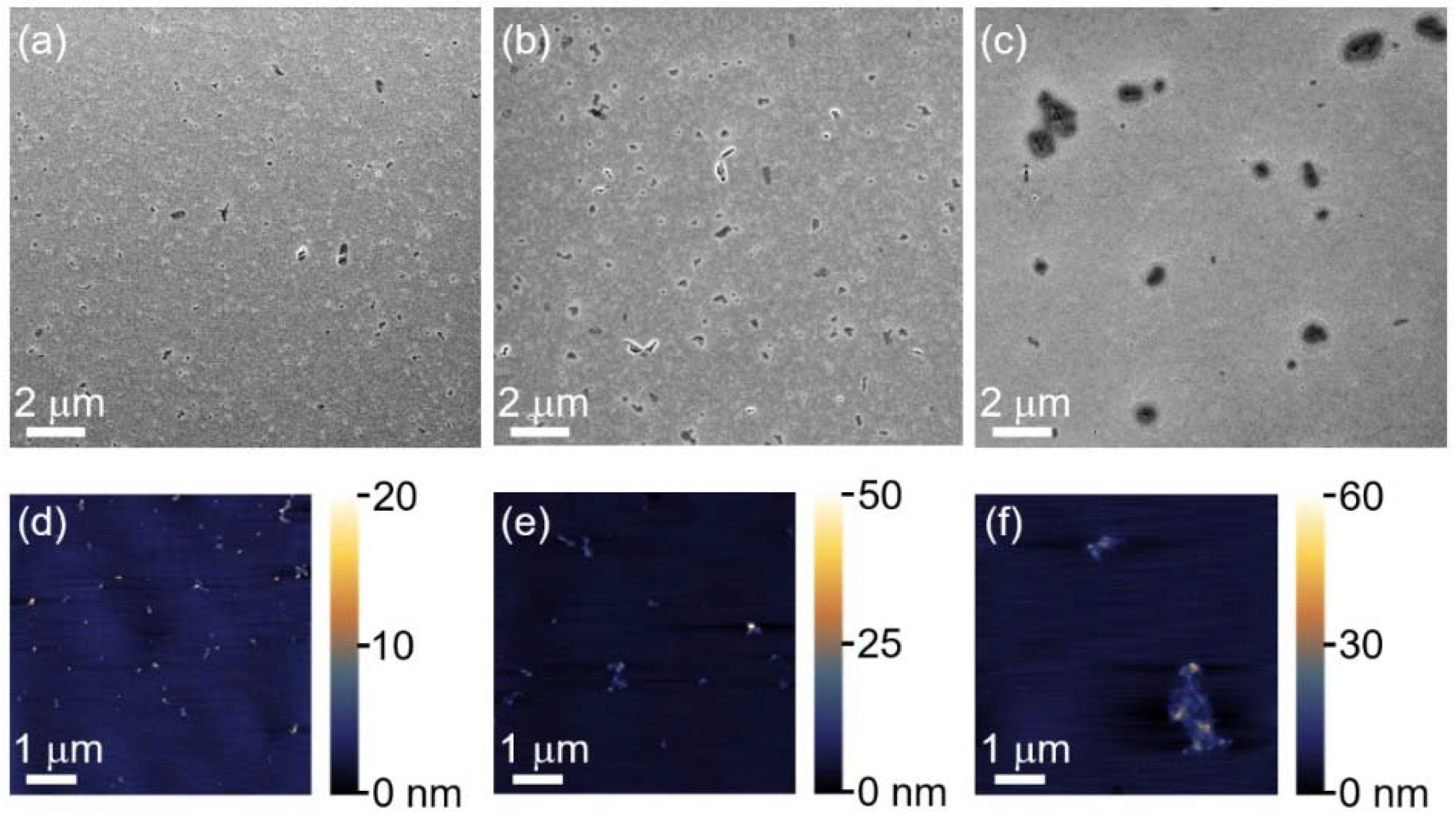
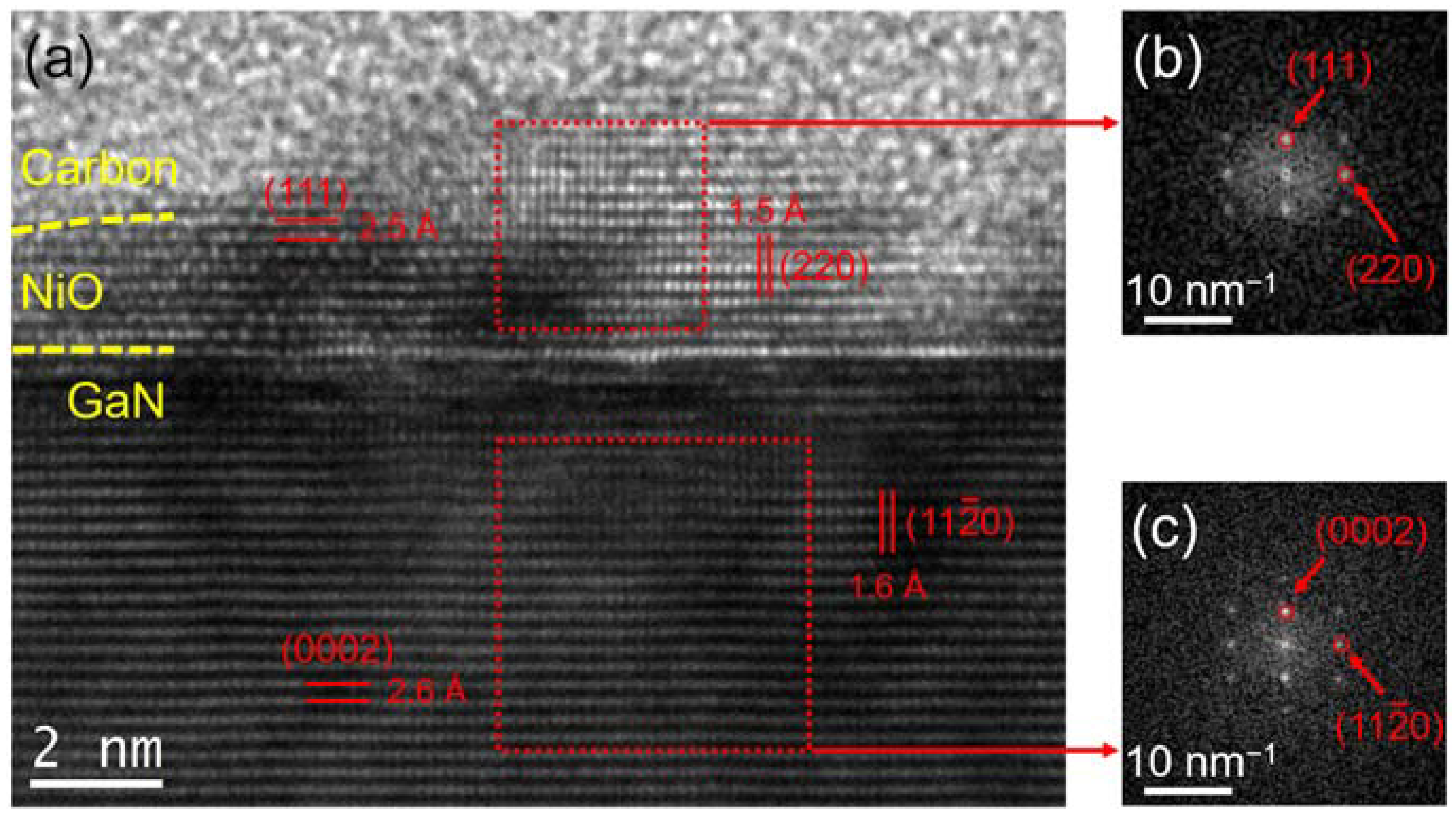
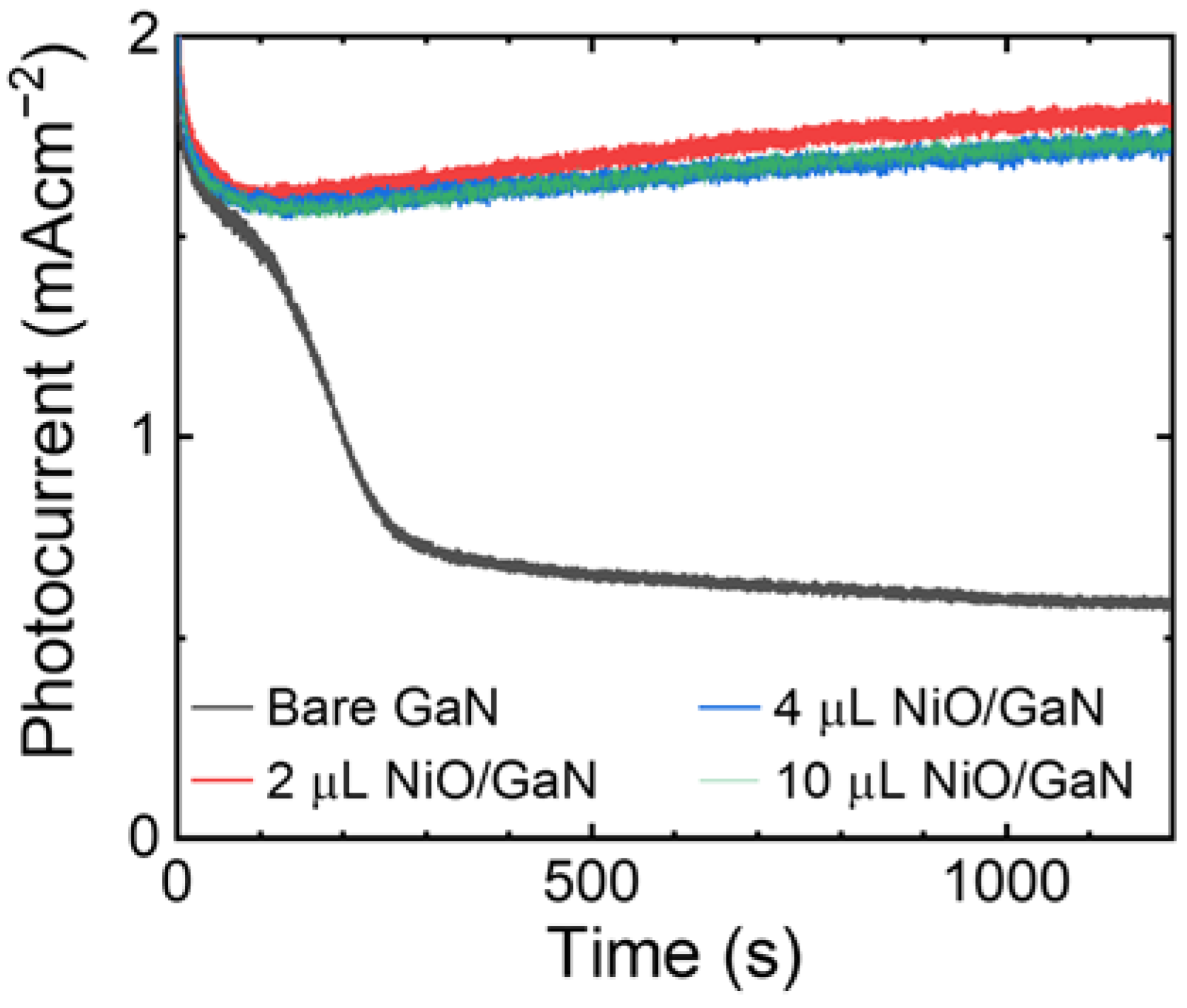
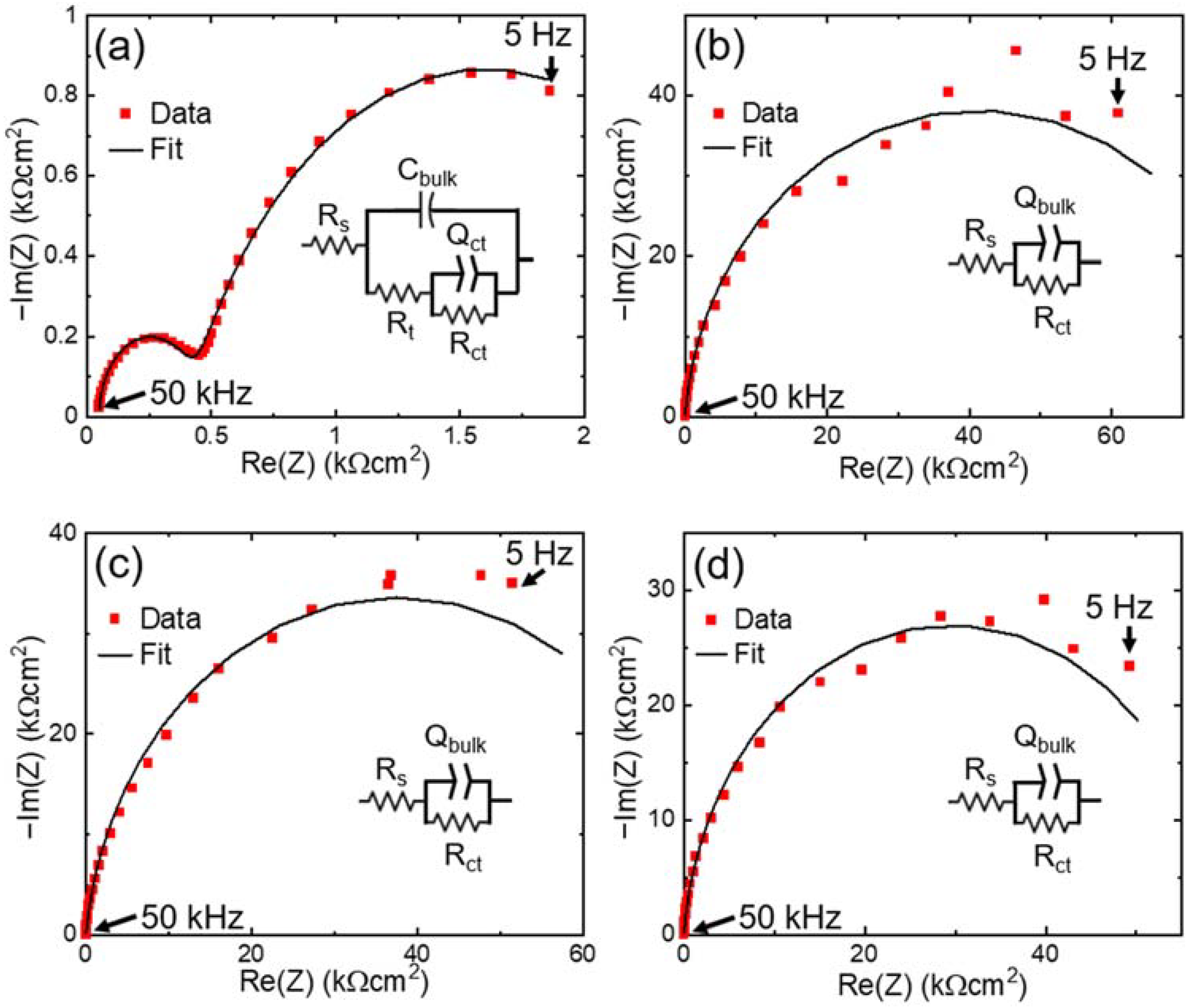
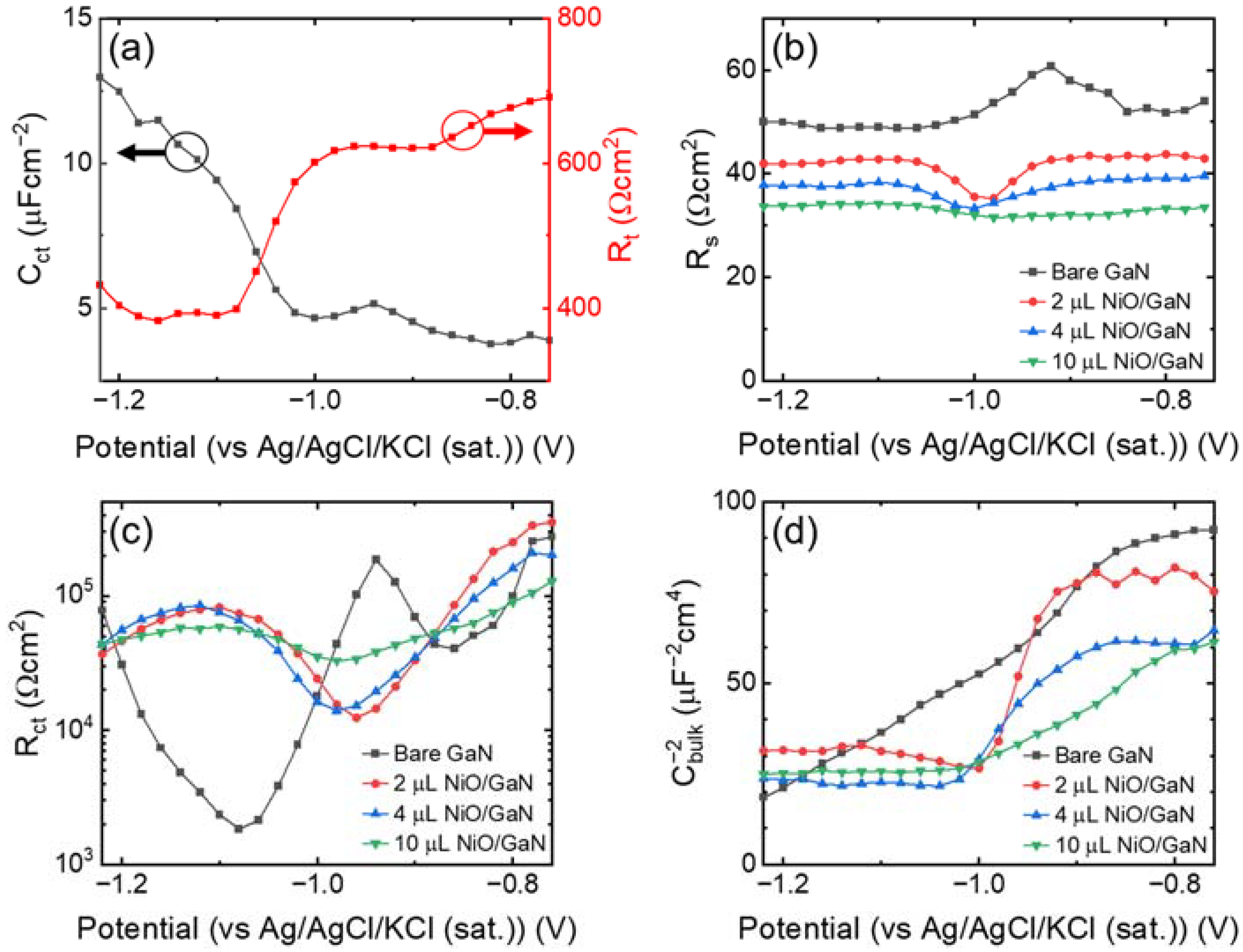
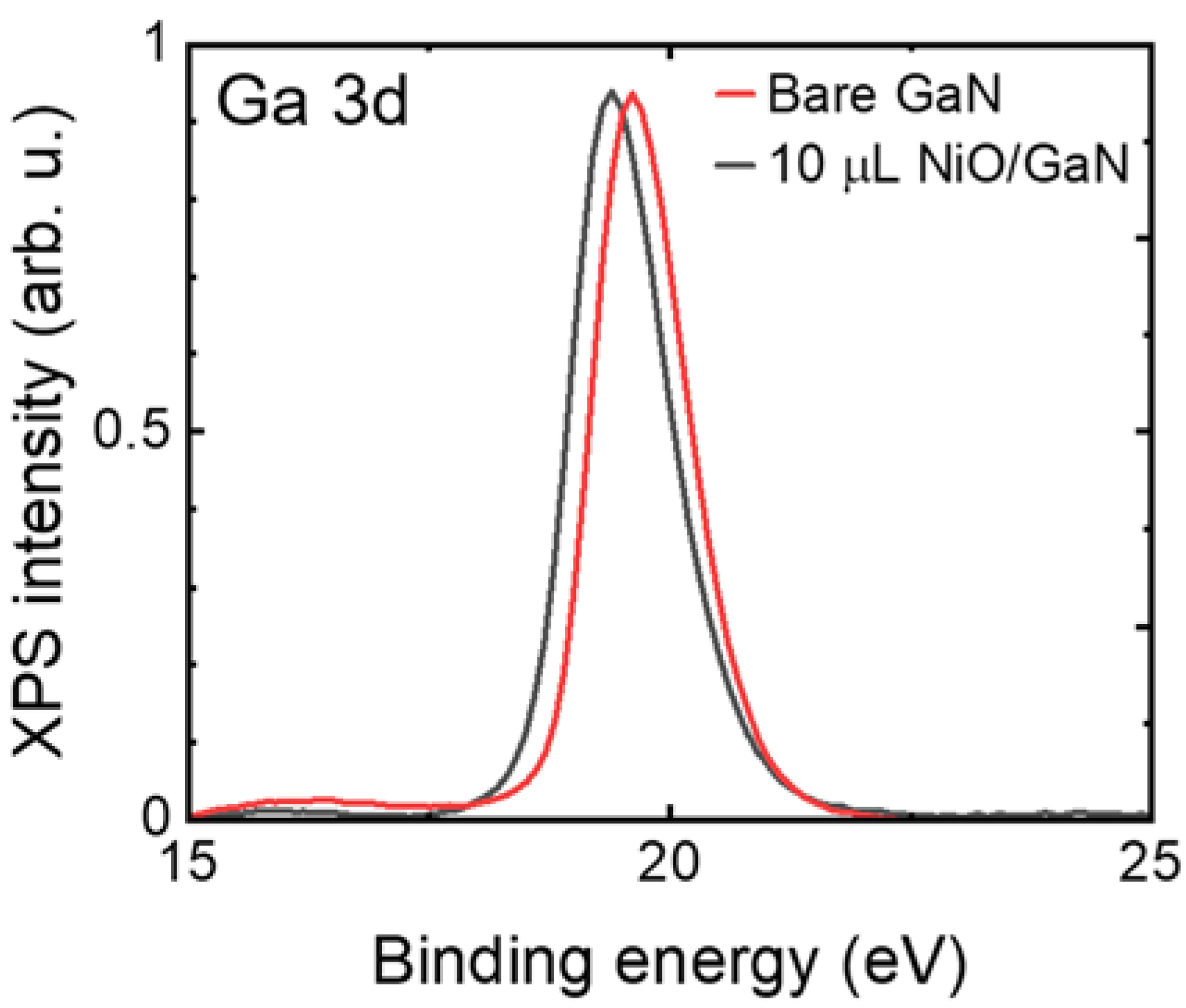
Publisher’s Note: MDPI stays neutral with regard to jurisdictional claims in published maps and institutional affiliations. |
© 2022 by the authors. Licensee MDPI, Basel, Switzerland. This article is an open access article distributed under the terms and conditions of the Creative Commons Attribution (CC BY) license (https://creativecommons.org/licenses/by/4.0/).
Share and Cite
Velazquez-Rizo, M.; Kirilenko, P.; Iida, D.; Zhuang, Z.; Ohkawa, K. Passivation of Surface States in GaN by NiO Particles. Crystals 2022, 12, 211. https://doi.org/10.3390/cryst12020211
Velazquez-Rizo M, Kirilenko P, Iida D, Zhuang Z, Ohkawa K. Passivation of Surface States in GaN by NiO Particles. Crystals. 2022; 12(2):211. https://doi.org/10.3390/cryst12020211
Chicago/Turabian StyleVelazquez-Rizo, Martin, Pavel Kirilenko, Daisuke Iida, Zhe Zhuang, and Kazuhiro Ohkawa. 2022. "Passivation of Surface States in GaN by NiO Particles" Crystals 12, no. 2: 211. https://doi.org/10.3390/cryst12020211
APA StyleVelazquez-Rizo, M., Kirilenko, P., Iida, D., Zhuang, Z., & Ohkawa, K. (2022). Passivation of Surface States in GaN by NiO Particles. Crystals, 12(2), 211. https://doi.org/10.3390/cryst12020211







